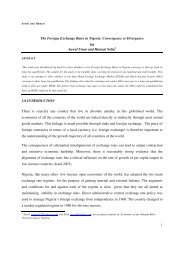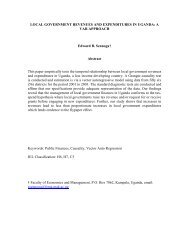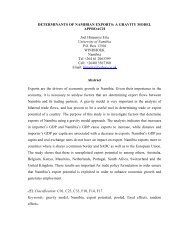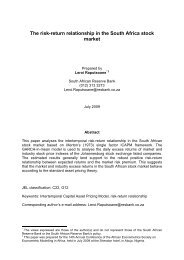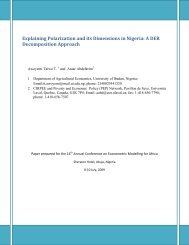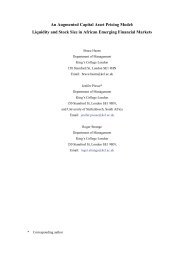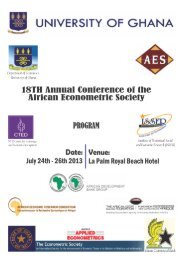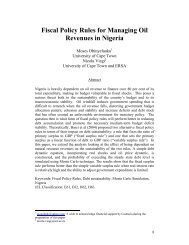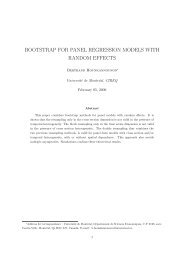Dynamic Effects of Monetary Policy Shocks in Malawi* - African ...
Dynamic Effects of Monetary Policy Shocks in Malawi* - African ...
Dynamic Effects of Monetary Policy Shocks in Malawi* - African ...
You also want an ePaper? Increase the reach of your titles
YUMPU automatically turns print PDFs into web optimized ePapers that Google loves.
4.3. The Composite ModelPrelim<strong>in</strong>ary <strong>in</strong>dications from the preced<strong>in</strong>g section suggest that bank lend<strong>in</strong>g, exchange rate andmoney effect channels conta<strong>in</strong> important additional <strong>in</strong>formation for the country‟s monetarytransmission process. Putt<strong>in</strong>g everyth<strong>in</strong>g together, a composite model <strong>of</strong> monetary transmission<strong>in</strong> Malawi can be drawn with the follow<strong>in</strong>g vector <strong>of</strong> endogenous variables:which is identified accord<strong>in</strong>g to system <strong>of</strong> equations (3.6). Impulse responses for theconsolidated model over a five year period are presented <strong>in</strong> Figure D1 <strong>in</strong> Appendix D. The figureillustrates that bank lend<strong>in</strong>g and money effect are important channels <strong>of</strong> monetary transmission<strong>in</strong> Malawi but the transmission process is somewhat weak. Among the three <strong>in</strong>termediate policytargets, none responds significantly to reserve money shocks while only bank lend<strong>in</strong>g and M2respond significantly to bank rate shocks, although the M2 response is only marg<strong>in</strong>allysignificant. Bank lend<strong>in</strong>g responds to a 2.2 percent sudden <strong>in</strong>crease <strong>in</strong> the bank rate with adecl<strong>in</strong>e, bottom<strong>in</strong>g at 1.7 percent below basel<strong>in</strong>e after 2 years. The response is significantbetween 12 and 30 months. M2 responds to the shock with an <strong>in</strong>stantaneous decl<strong>in</strong>e <strong>of</strong> 0.8percent, before ris<strong>in</strong>g <strong>in</strong> the next 6 months and decl<strong>in</strong><strong>in</strong>g thereafter. The response is marg<strong>in</strong>allysignificant between 16 and 24 months.Output responds significantly to unexpected changes <strong>in</strong> both bank lend<strong>in</strong>g and M2. Anunanticipated 5.7 percent <strong>in</strong>crease <strong>in</strong> bank lend<strong>in</strong>g causes output to rise, peak<strong>in</strong>g at 1.3 percentabove basel<strong>in</strong>e after 15 months. A sudden 5.8 percent <strong>in</strong>crease <strong>in</strong> M2 also causes output to rise,peak<strong>in</strong>g at 1.6 percent above basel<strong>in</strong>e after 5 months. Consumer prices, however, respond<strong>in</strong>significantly to shocks emanat<strong>in</strong>g from both bank lend<strong>in</strong>g and M2, consistent with earlierf<strong>in</strong>d<strong>in</strong>gs.The money effect channel is strengthened by significant responses <strong>of</strong> M2 to bank lend<strong>in</strong>g andexchange rate shocks. In contrast, the exchange rate channel is not well established. Exchangerates respond <strong>in</strong>significantly to all monetary variables <strong>in</strong> the model but they prompt significantresponses <strong>in</strong> both output and consumer prices. Thus, while there is no evidence that they aredriven by monetary policy shocks, exchange rates are an important determ<strong>in</strong>ant <strong>of</strong> output andconsumer prices. On this basis, it is probable that exchange rates are exogenously determ<strong>in</strong>ed <strong>in</strong>the model. To ascerta<strong>in</strong> this claim, the composite model is re-estimated with the exchange ratetreated as an exogenous variable and similar results are obta<strong>in</strong>ed (see Figure D2 <strong>in</strong> Appendix D).Historical events suggest that f<strong>in</strong>ancial sector operations dur<strong>in</strong>g the pre-1994 period wereconsiderably different <strong>in</strong> comparison to the post-1994 period. The country had credit ceil<strong>in</strong>gsuntil 1988, direct <strong>in</strong>terest rate controls until May 1990 and a fixed exchange rate peg untilFebruary 1994. In the post-1994 period, numerous f<strong>in</strong>ancial <strong>in</strong>novations emerged, the number <strong>of</strong>commercial banks <strong>in</strong>creased considerably and the f<strong>in</strong>ancial sector become reasonablycompetitive. Cognisant that the impact <strong>of</strong> f<strong>in</strong>ancial sector operations on economic activity mayhave also changed <strong>in</strong> the post-1994 period, the composite model (with endogenous exchange27 | P a g e(4.9)



